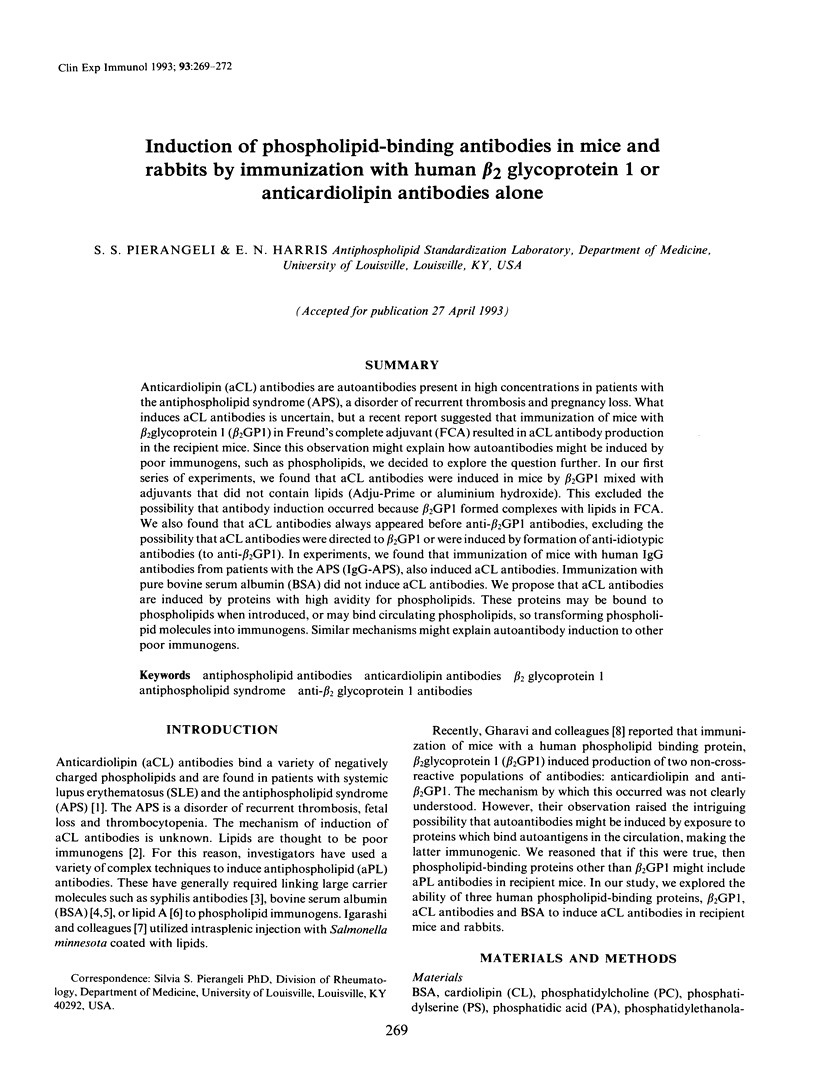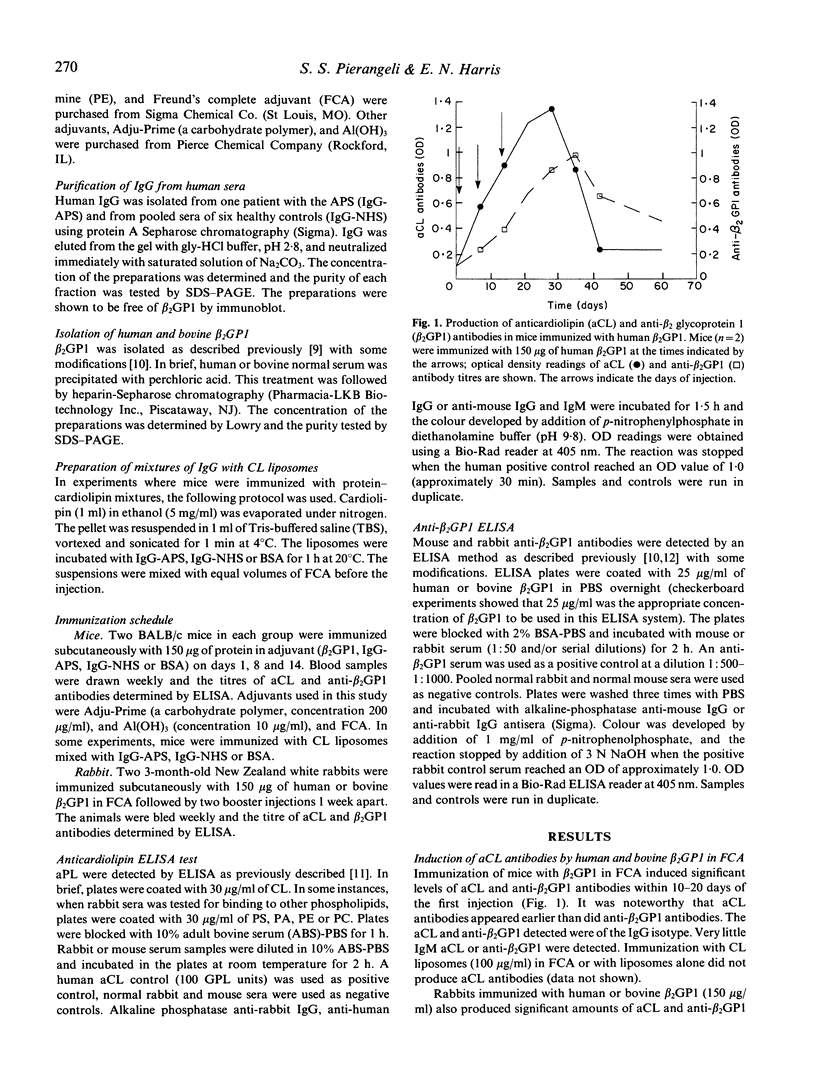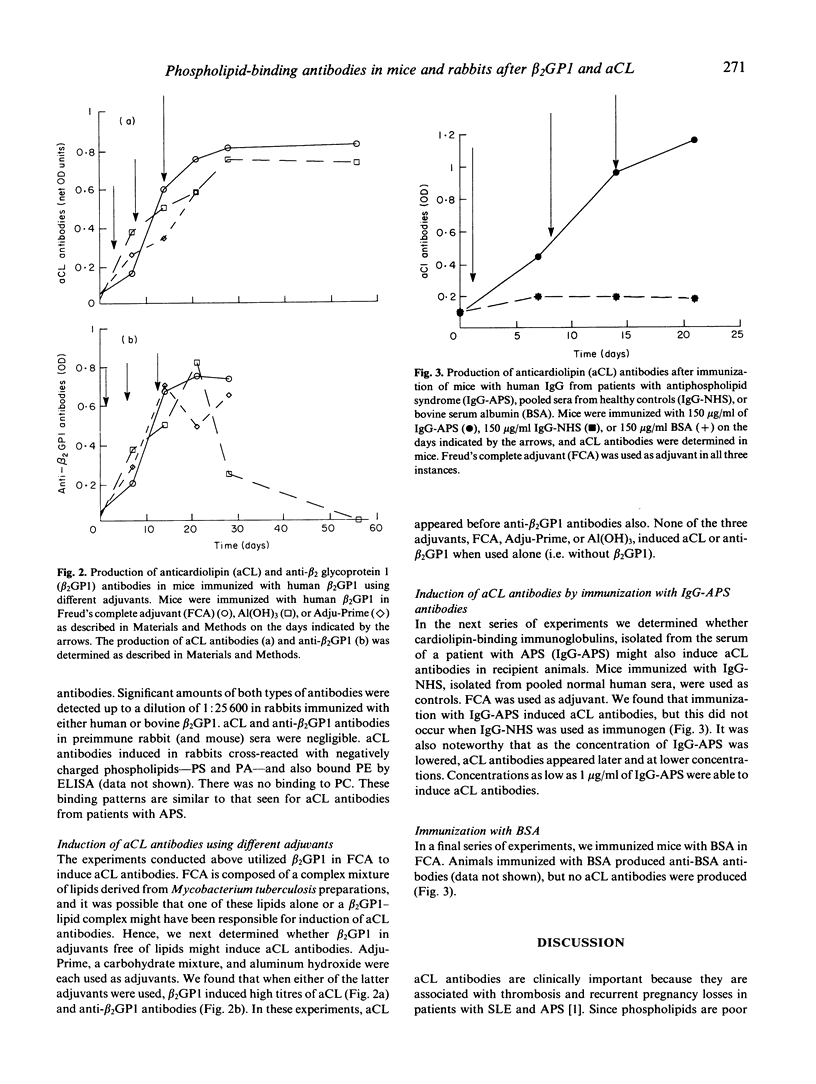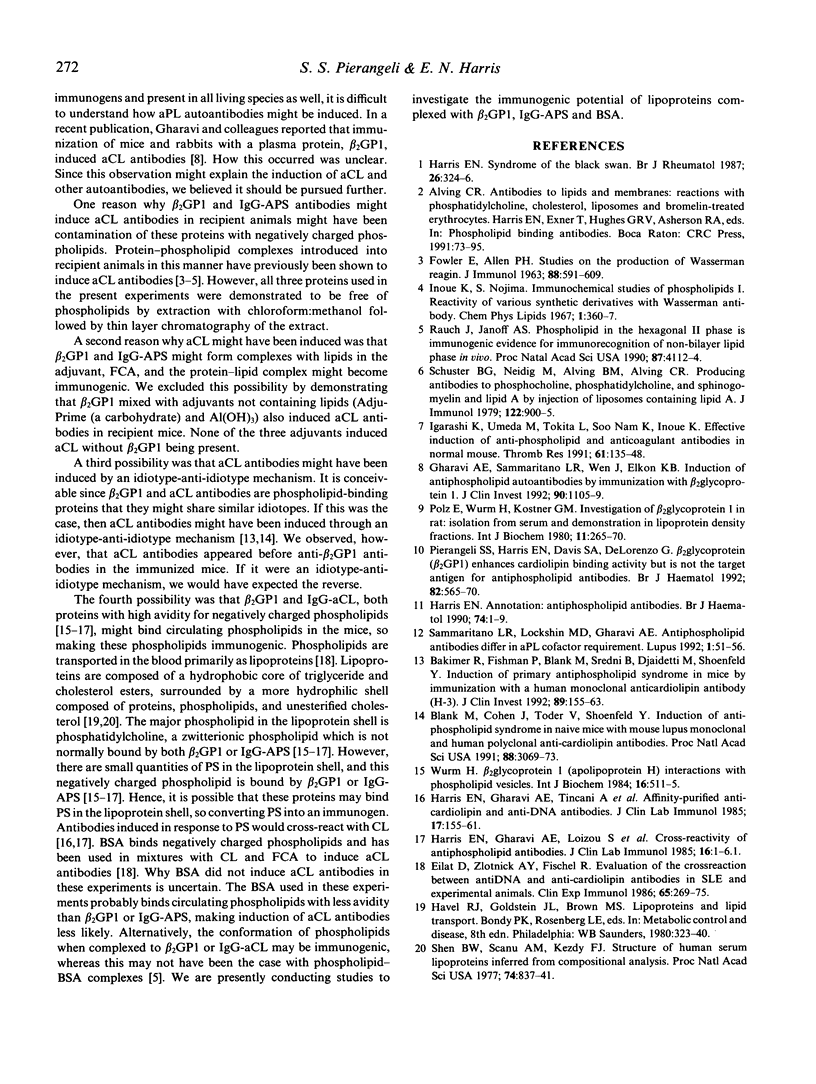Abstract
Anticardiolipin (aCL) antibodies are autoantibodies present in high concentrations in patients with the antiphospholipid syndrome (APS), a disorder of recurrent thrombosis and pregnancy loss. What induces aCL antibodies is uncertain, but a recent report suggested that immunization of mice with beta 2 glycoprotein 1 (beta 2 GP1) in Freund's complete adjuvant (FCA) resulted in aCL antibody production in the recipient mice. Since this observation might explain how autoantibodies might be induced by poor immunogens, such as phospholipids, we decided to explore the question further. In our first series of experiments, we found that aCL antibodies were induced in mice by beta 2GP1 mixed with adjuvants that did not contain lipids (Adju-Prime or aluminium hydroxide). This excluded the possibility that antibody induction occurred because beta 2GP1 formed complexes with lipids in FCA. We also found that aCL antibodies always appeared before anti-beta 2GP1 antibodies, excluding the possibility that aCL antibodies were directed to beta 2GP1 or were induced by formation of anti-idiotypic antibodies (to anti-beta 2GP1). In experiments, we found that immunization of mice with human IgG antibodies from patients with the APS (IgG-APS), also induced aCL antibodies. Immunization with pure bovine serum albumin (BSA) did not induce aCL antibodies. We propose that aCL antibodies are induced by proteins with high avidity for phospholipids. These proteins may be bound to phospholipids when introduced, or may bind circulating phospholipids, so transforming phospholipid molecules into immunogens. Similar mechanisms might explain autoantibody induction to other poor immunogens.
Full text
PDF



Selected References
These references are in PubMed. This may not be the complete list of references from this article.
- Bevers E. M., Galli M. Cofactors involved in the antiphospholipid syndrome. Lupus. 1992 Feb;1(2):51–53. doi: 10.1177/096120339200100201. [DOI] [PubMed] [Google Scholar]
- Blank M., Cohen J., Toder V., Shoenfeld Y. Induction of anti-phospholipid syndrome in naive mice with mouse lupus monoclonal and human polyclonal anti-cardiolipin antibodies. Proc Natl Acad Sci U S A. 1991 Apr 15;88(8):3069–3073. doi: 10.1073/pnas.88.8.3069. [DOI] [PMC free article] [PubMed] [Google Scholar]
- Eilat D., Zlotnick A. Y., Fischel R. Evaluation of the cross-reaction between anti-DNA and anti-cardiolipin antibodies in SLE and experimental animals. Clin Exp Immunol. 1986 Aug;65(2):269–278. [PMC free article] [PubMed] [Google Scholar]
- FOWLER E., ALLEN R. H. Studies on the production of Wassermann reagin. J Immunol. 1962 May;88:591–594. [PubMed] [Google Scholar]
- Gharavi A. E., Sammaritano L. R., Wen J., Elkon K. B. Induction of antiphospholipid autoantibodies by immunization with beta 2 glycoprotein I (apolipoprotein H). J Clin Invest. 1992 Sep;90(3):1105–1109. doi: 10.1172/JCI115927. [DOI] [PMC free article] [PubMed] [Google Scholar]
- Harris E. N. Antiphospholipid antibodies. Br J Haematol. 1990 Jan;74(1):1–9. doi: 10.1111/j.1365-2141.1990.tb02530.x. [DOI] [PubMed] [Google Scholar]
- Harris E. N., Gharavi A. E., Loizou S., Derue G., Chan J. K., Patel B. M., Mackworth-Young C. G., Bunn C. C., Hughes G. R. Crossreactivity of antiphospholipid antibodies. J Clin Lab Immunol. 1985 Jan;16(1):1–6. [PubMed] [Google Scholar]
- Harris E. N., Gharavi A. E., Tincani A., Chan J. K., Englert H., Mantelli P., Allegro F., Ballestrieri G., Hughes G. R. Affinity purified anti-cardiolipin and anti-DNA antibodies. J Clin Lab Immunol. 1985 Aug;17(4):155–162. [PubMed] [Google Scholar]
- Harris E. N. Syndrome of the black swan. Br J Rheumatol. 1987 Oct;26(5):324–326. doi: 10.1093/rheumatology/26.5.324. [DOI] [PubMed] [Google Scholar]
- Igarashi K., Umeda M., Tokita S., Nam K. S., Inoue K. Effective induction of anti-phospholipid and anticoagulant antibodies in normal mouse. Thromb Res. 1991 Jan 15;61(2):135–148. doi: 10.1016/0049-3848(91)90240-w. [DOI] [PubMed] [Google Scholar]
- Pierangeli S. S., Harris E. N., Davis S. A., DeLorenzo G. Beta 2-glycoprotein 1 (beta 2GP1) enhances cardiolipin binding activity but is not the antigen for antiphospholipid antibodies. Br J Haematol. 1992 Nov;82(3):565–570. doi: 10.1111/j.1365-2141.1992.tb06468.x. [DOI] [PubMed] [Google Scholar]
- Polz E., Wurm H., Kostner G. M. Investigations on beta 2-glycoprotein-I in the rat: isolation from serum and demonstration in lipoprotein density fractions. Int J Biochem. 1980;11(3-4):265–270. doi: 10.1016/0020-711x(80)90229-3. [DOI] [PubMed] [Google Scholar]
- Rauch J., Janoff A. S. Phospholipid in the hexagonal II phase is immunogenic: evidence for immunorecognition of nonbilayer lipid phases in vivo. Proc Natl Acad Sci U S A. 1990 Jun;87(11):4112–4114. doi: 10.1073/pnas.87.11.4112. [DOI] [PMC free article] [PubMed] [Google Scholar]
- Schuster B. G., Neidig M., Alving B. M., Alving C. R. Production of antibodies against phosphocholine, phosphatidylcholine, sphingomyelin, and lipid A by injection of liposomes containing lipid A. J Immunol. 1979 Mar;122(3):900–905. [PubMed] [Google Scholar]
- Shen B. W., Scanu A. M., Kézdy F. J. Structure of human serum lipoproteins inferred from compositional analysis. Proc Natl Acad Sci U S A. 1977 Mar;74(3):837–841. doi: 10.1073/pnas.74.3.837. [DOI] [PMC free article] [PubMed] [Google Scholar]
- Wurm H. beta 2-Glycoprotein-I (apolipoprotein H) interactions with phospholipid vesicles. Int J Biochem. 1984;16(5):511–515. doi: 10.1016/0020-711x(84)90168-x. [DOI] [PubMed] [Google Scholar]


